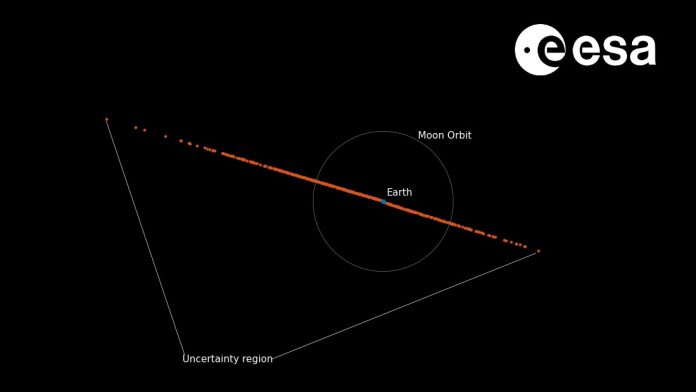
At the end of 2024, astronomers detected an asteroid in the night sky.
It was given the designation Y, since it was discovered in the last half of December, and R4 since it was the 117th rock to be found in the last couple of weeks of December, and since it was discovered in 2024, it was assigned the name 2024 YR4.
Naturally, once a rock is found, astronomers start keeping track of it, measuring its position to get a handle on its orbit.
In this case, the estimated orbit put it at a 1% chance of striking Earth.
As more measurements were taken, those odds have more than doubled.
As of this writing, it now has a 2.3% chance of striking Earth on December 22, 2032. While you might think this resembles the plot of Don’t Look Up, none of this is too unusual.
You can see this in the image above, which indicates potential trajectory points. The 2.3% odds aren’t simply the chances of a die roll.
What it means is that when astronomers run 1,000 orbital simulations based on the data we have, 23 of them impact Earth.
The most probable trajectory currently estimates that it will have a close approach of 240,000 km from Earth, which is within the orbit of the Moon but not dangerously close.
So while the odds have doubled, astronomers aren’t too worried. When 2024 YR4 had a risk of less than 1%, NASA’s Planetary Defense Coordination Office (PDCO) ranked it a 3 on the Torino scale, meaning we should keep an eye on it. At a 2.3% risk, it is still a 3.
When it comes to tracking asteroids like this, the one thing we are certain of is that early estimates are uncertain. Unlike the orbits of planets, the orbits of asteroids can be remarkably fuzzy.
Gravitational tugs from nearby objects can shift them around. In the case of 024 YR4, one big source of uncertainty is Earth itself. In 2028, it will pass within 8 million kilometers of Earth.
This is actually when astronomers will be able to make much more precise measurements of its orbit. We will then see whether we need to start making plans. Even if astronomers find out the odds of impact are almost 100%, we still wouldn’t need to panic, for a few reasons.
The first is that we know it’s there. The real risk of asteroids isn’t from the ones slowly approaching Earth from the outer solar system.
The bigger risks are ones such as Chelyabinsk which came from the direction of the Sun and caught us by surprise. We still have years to deal with 2024 YR4, and its orbit is such that we would have a good chance of deflecting it. And even if the absolute worst-case scenario were to occur, 2024 YR4 isn’t large enough to cause an extinction event.
The absolute nightmare scenario is that it would strike Earth in a heavily populated area. We’d have to evacuate people from the risk zone, but we would have a few years to do that. An impact would be bad, but we could minimize the risk significantly.
Even with all that said, it’s important to keep in mind that early trajectory calculations can vary significantly.
The odds may rise significantly again before dropping, but the most likely outcome is that the odds will eventually drop to zero.
If you want to keep tabs on 2024 YR4, check out NASA’s Planetary Defense Page.
Written by Brian Koberlein/Universe Today.



